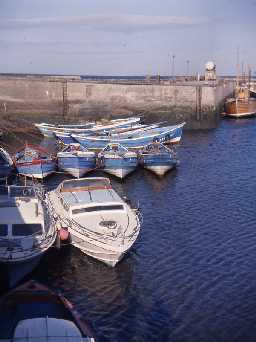Local History
North Sunderland and Seahouses (Northumberland)
North Sunderland is a small parish on the north Northumberland coast, which also includes the Farne Islands.
The earliest remains in the parish is a Neolithic cup and ring marked stone, found near a Bronze Age burial at Seahouses. Where it was originally carved is unknown, but it may have continued to hold some significance to Bronze Age people. Another Bronze Age burial was found in a cist at North Sunderland and a standing stone is known at Seahouses.
Although there are no definite Iron Age or Roman period settlements, cropmarks of a double ditched enclosure may be from this period.
In the early medieval period, islands were particularly favoured places for the early Northumbrian Christians to seek solitude. St Cuthbert and a succession of other hermits lived on Inner Farne and the island eventually became a place of pilgrimage in medieval times.
The association with St Cuthbert dominates records of the medieval parish. A small Benedictine cell developed on Inner Farne around the two chapels of St Mary and St Cuthbert. Although the monks were reliant to a degree on produce from the mainland, they managed to cultivate part of the island and traces of ridge and furrow ploughing can still be seen today. On the mainland there were granges to support the monks on the islands, such as at Monks House.
Away from the religious life, people lived in villages and hamlets at Old Shoreston and North Sunderland, farming the surrounding land. Traces of medieval ridge and furrow can be seen behind St Aidan's Dunes.
The medieval period was also a time of warfare between England and Scotland and a tower house was built in North Sunderland and even on Inner Farne. Prior Castell's Tower, on Inner Farne, was built around 1500 and was later used as a fort and a lighthouse.
In post-medieval times the old village of North Sunderland was overtaken by a new settlement, called Seahouses, which developed around the fishing industry. Lime kilns were established at the side of the harbour and the lime exported to Scotland. However, not all voyages in the area were successful. One of the most famous wrecks is that of the SS Forfarshire whose crew was rescued by the Longstone lighthouse keeper and his daughter, Grace Darling.
In the early 20th century several houses have been built in the Arts and Crafts style at Shoreston to exemplify country living, away from industrialised areas and without mass-produced articles. They include Shoreston Hall, East and West House, Shoreston Cottage and Shoreston House.
The earliest remains in the parish is a Neolithic cup and ring marked stone, found near a Bronze Age burial at Seahouses. Where it was originally carved is unknown, but it may have continued to hold some significance to Bronze Age people. Another Bronze Age burial was found in a cist at North Sunderland and a standing stone is known at Seahouses.
Although there are no definite Iron Age or Roman period settlements, cropmarks of a double ditched enclosure may be from this period.
In the early medieval period, islands were particularly favoured places for the early Northumbrian Christians to seek solitude. St Cuthbert and a succession of other hermits lived on Inner Farne and the island eventually became a place of pilgrimage in medieval times.
The association with St Cuthbert dominates records of the medieval parish. A small Benedictine cell developed on Inner Farne around the two chapels of St Mary and St Cuthbert. Although the monks were reliant to a degree on produce from the mainland, they managed to cultivate part of the island and traces of ridge and furrow ploughing can still be seen today. On the mainland there were granges to support the monks on the islands, such as at Monks House.
Away from the religious life, people lived in villages and hamlets at Old Shoreston and North Sunderland, farming the surrounding land. Traces of medieval ridge and furrow can be seen behind St Aidan's Dunes.
The medieval period was also a time of warfare between England and Scotland and a tower house was built in North Sunderland and even on Inner Farne. Prior Castell's Tower, on Inner Farne, was built around 1500 and was later used as a fort and a lighthouse.
In post-medieval times the old village of North Sunderland was overtaken by a new settlement, called Seahouses, which developed around the fishing industry. Lime kilns were established at the side of the harbour and the lime exported to Scotland. However, not all voyages in the area were successful. One of the most famous wrecks is that of the SS Forfarshire whose crew was rescued by the Longstone lighthouse keeper and his daughter, Grace Darling.
In the early 20th century several houses have been built in the Arts and Crafts style at Shoreston to exemplify country living, away from industrialised areas and without mass-produced articles. They include Shoreston Hall, East and West House, Shoreston Cottage and Shoreston House.
N13842
UNCERTAIN
Disclaimer -
Please note that this information has been compiled from a number of different sources. Durham County Council and Northumberland County Council can accept no responsibility for any inaccuracy contained therein. If you wish to use/copy any of the images, please ensure that you read the Copyright information provided.
